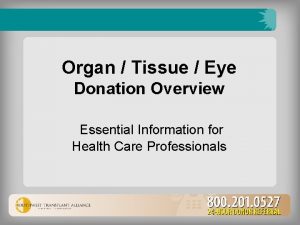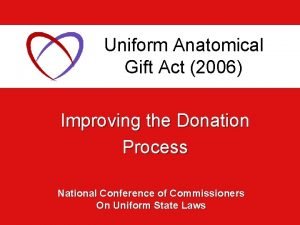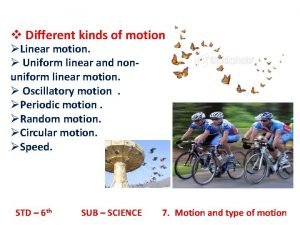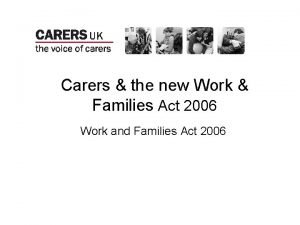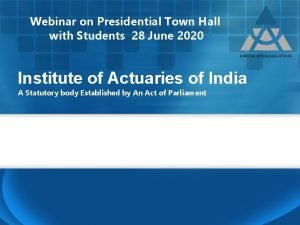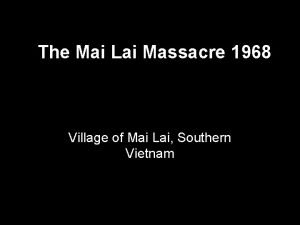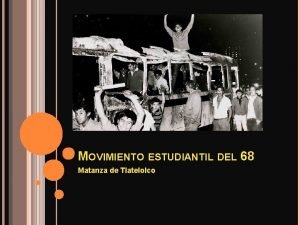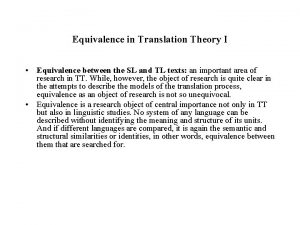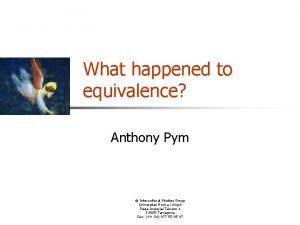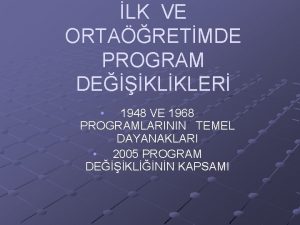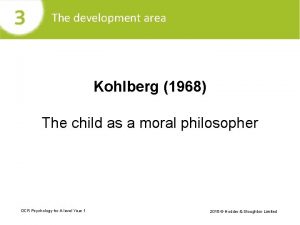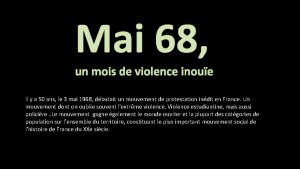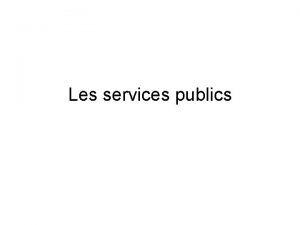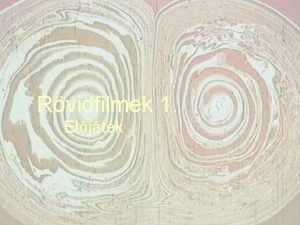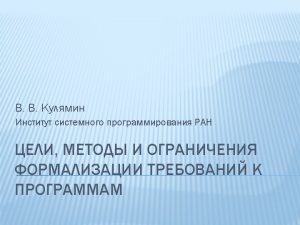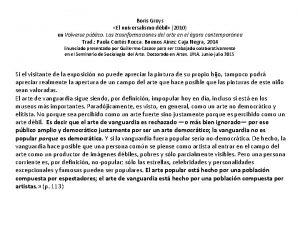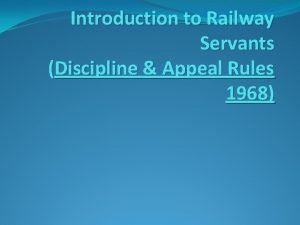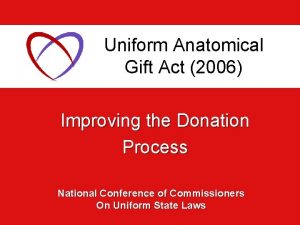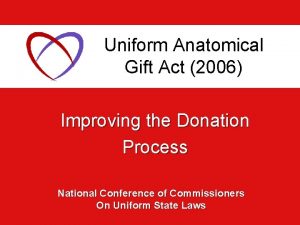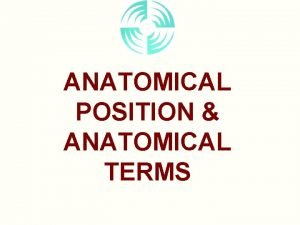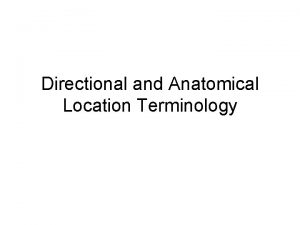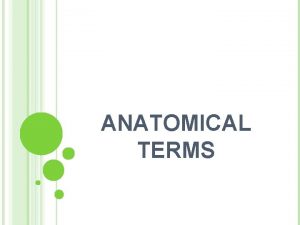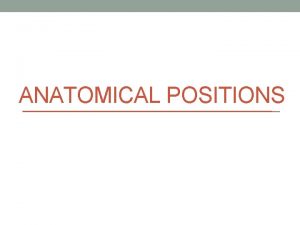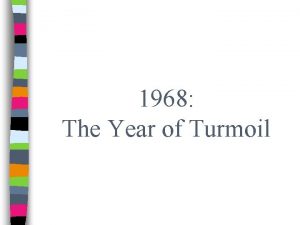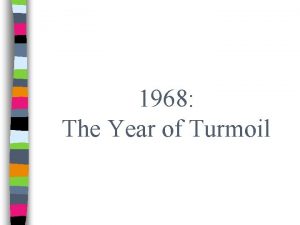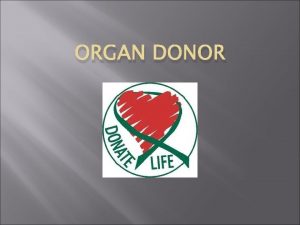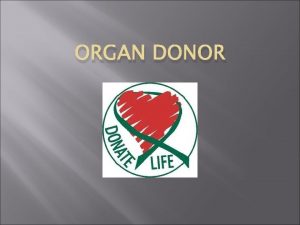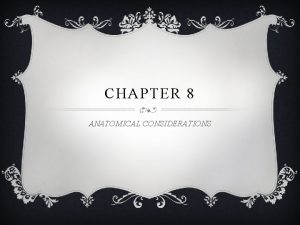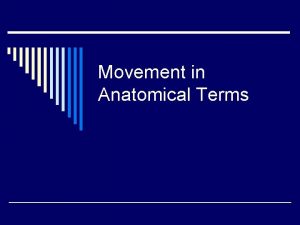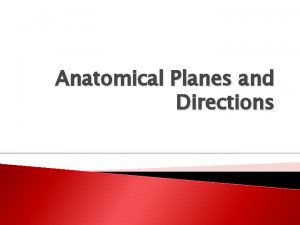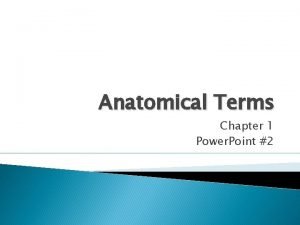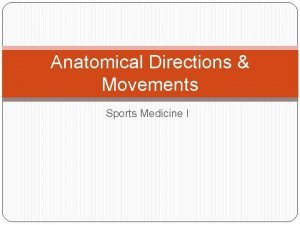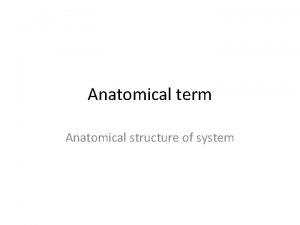Uniform Anatomical Gift Act UAGA 2006 UAGA 1968






























- Slides: 30



















アメリカでは Uniform Anatomical Gift Act (UAGA) 2006 ①UAGA 1968, shortly after Dr. Christian Barnard’s successful transplant of a heart in November, 1967. Promptly and uniformly enacted in every jurisdiction. ②Only 26 states enacted the 1987 UAGA, resulting in non-uniformity. Subsequent changes in each state over the years have resulted in even less uniformity. ③ The 2006 UAGA is an effort to resolve any perceived inconsistencies thereby adding to the efficiency of the current system. 19

★Summary of Changes in the New Act: This revision: 1. Honors the choice of an individual to be or not to be a donor and strengthens the language barring others from overriding a donor’s decision to make an anatomical gift (Section 8); 2. Facilitates donations by expanding the list of those who may make an anatomical gift for another individual during that individual’s lifetime to include health-care agents and, under certain circumstances, parents or guardians (Section 4); 3. Empowers a minor eligible under other law to apply for a driver’s license to be a donor (Section 4); 20

4. Facilitates donations from a deceased individual who made no lifetime choice by adding to the list of persons who can make a gift of the deceased individual’s body or parts the following persons: the person who was acting as the decedent’s agent under a power of attorney for health care at the time of the decedent’s death, the decedent’s adult grandchildren, and an adult who exhibited special care and concern for the decedent (Section 9). . . ; 5. Permits an anatomical gift by any member of a class where there is more than one person in the class so long as no objections by other class members are known and, if an objection is known, permits a majority of the members of the class who are reasonably available to make the gift without having to take account of a known objection by any class member who is not reasonably available (Sec. 9); 21

6. Creates numerous default rules for the interpretation of a document of gift that lacks specificity regarding either the persons to receive the gift or the purposes of the gift or both (Section 11); 7. Encourages and establishes standards for donor registries (Section 20); 8. Enables procurement organizations to gain access to documents of gifts in donor registries, medical records, and the records of a state motor vehicle department (Sections 14 and 20); 9. Resolves the tension between a health-care directive requesting the withholding or withdrawal of life support systems and anatomical gifts by permitting measures necessary to ensure the medical suitability of organs for intended transplantation or therapy to be administered (Sections 14 and 21); 22

10. Clarifies and expands the rules relating to cooperation and coordination between procurement organizations and coroners or medical examiners (Sections 22 and 23); 11. Recognizes anatomical gifts made under the laws of other jurisdictions (Section 19); and 12. Updates the [act] to allow for electronic records and signatures (Section 25). 23

§ 4. WHO MAY MAKE ANATOMICAL GIFT BEFORE DONOR’S DEATH. Subject to Section 8, an anatomical gift of a donor’s body or part may be made during the life of the donor for the purpose of transplantation, therapy, research, or education in the manner provided in Section 5 by: (1) the donor, if the donor is an adult or if the donor is a minor and is: (A) emancipated; or (B) authorized under state law to apply for a driver’s license because the donor is at least [insert the youngest age at which an individual may apply for any type of driver’s license] years of age; (2) an agent of the donor, unless the power of attorney for health care or other record prohibits the agent from making an anatomical gift; (3) a parent of the donor, if the donor is an unemancipated minor; or (4) the donor’s guardian. 24

DONOR CARD I wish to donate my organs, eyes, and tissue. I give: Any needed organs, eyes, and tissue ONLY the following organs, eyes, and tissue: _____________________ Date: ___________ Donor’s Signature _________ 25

DONOR CARD I wish to donate my organs, eyes, and tissue. I wish to give (complete either Section A, B, or C): Purpose of Gift: Transplantation or therapy Research or Education Both Subject of Gift: ALL of my organs, eyes, and tissue My Organs My Eyes My Tissue Special Instructions (If none of the above apply), I wish to give ONLY: _______________________________ Date: _________ Donor’s Signature: _________ 26

DONOR CARD I give, upon my death, the following gifts for the purpose of (choose whichever applies): [ ] only transplantation and therapy, [ ] only research and education, [ ] transplantation, therapy, research, or education For the purposes specified above, I give: [ ] ALL needed organs, tissues, and eyes; or (If you checked the box immediately above, you should not check specific boxes below). [ ] Organs [ ] Tissues [ ] Eyes If none of the above applies, I wish to give ONLY: The following organs and tissues: ___________________ Date: __________ Donor’s Signature: ___________ 27

SECTION 8. PRECLUSIVE EFFECT OF ANATOMICAL GIFT, AMENDMENT, OR REVOCATION. (a) Except as otherwise provided in subsection (g) and subject to subsection (f), in the absence of an express, contrary indication by the donor, a person other than the donor is barred from making, amending, or revoking an anatomical gift of a donor’s body or part if the donor made an anatomical gift of the donor’s body or part under Section 5 or an amendment to an anatomical gift of the donor’s body or part under Section 6. . 28

§ 9. WHO MAY MAKE ANATOMICAL GIFT OF DECEDENT’S BODY OR PART. (a) Subject to subsections (b) and (c) and unless barred by Section 7 or 8, an anatomical gift of a decedent’s body or part for purpose of transplantation, therapy, research, or education may be made by any member of the following classes of persons who is reasonably available, in the order of priority listed: (1) an agent of the decedent at the time of death who could have made an anatomical gift under Section 4(2) immediately before the decedent’s death; (2) the spouse of the decedent; (3) adult children of the decedent; (4) parents of the decedent; (5) adult siblings of the decedent; (6) adult grandchildren of the decedent; (7) grandparents of the decedent; (8) an adult who exhibited special care and concern for the decedent; (9) the persons who were acting as the [guardians] of the person of the decedent at the time of death; and (10) any other person having the authority to dispose of the decedent’s body. 29

(b) If there is more than one member of a class listed in subsection (a)(1), (3), (4), (5), (6), (7), or (9) entitled to make an anatomical gift, an anatomical gift may be made by a member of the class unless that member or a person to which the gift may pass under Section 11 knows of an objection by another member of the class. If an objection is known, the gift may be made only by a majority of the members of the class who are reasonably available. (c) A person may not make an anatomical gift if, at the time of the decedent’s death, a person in a prior class under subsection (a) is reasonably available to make or to object to the making of an anatomical gift. 30
 Uniform anatomical gift act
Uniform anatomical gift act Uniform anatomical gift act definition
Uniform anatomical gift act definition Uniform anatomical gift act
Uniform anatomical gift act 9344
9344 How do you classify uniform and non-uniform mixtures?
How do you classify uniform and non-uniform mixtures? Grade 7 science unit 3 mixtures and solutions answers
Grade 7 science unit 3 mixtures and solutions answers Aliran seragam terjadi ketika
Aliran seragam terjadi ketika Type of motion
Type of motion Macbeth act 3-5 summary
Macbeth act 3-5 summary Work and families act 2006
Work and families act 2006 Actuaries act 2006
Actuaries act 2006 Food safety 2006
Food safety 2006 Mai lai massacre
Mai lai massacre Cost of living 1968
Cost of living 1968 Matanza de tlatelolco introduccion
Matanza de tlatelolco introduccion Edwin locke goal setting theory 1968
Edwin locke goal setting theory 1968 Otto kade 1968
Otto kade 1968 Directional equivalence
Directional equivalence 1968 programı
1968 programı Kohlberg 1968
Kohlberg 1968 Vietnam 1968
Vietnam 1968 Secouristes
Secouristes şebnem ünal 1979 türkiye güzeli şimdi ne yapıyor
şebnem ünal 1979 türkiye güzeli şimdi ne yapıyor Atkinson en shiffrin
Atkinson en shiffrin Tc 24 juin 1968 société distilleries bretonnes
Tc 24 juin 1968 société distilleries bretonnes Sgt. john kenneth ferrier
Sgt. john kenneth ferrier Mélyvíz 1970
Mélyvíz 1970 Software crisis 1968
Software crisis 1968 1966 1967 1968 1969 1970 1971 1972 1973 1974 1975
1966 1967 1968 1969 1970 1971 1972 1973 1974 1975 Boris groys volverse publico
Boris groys volverse publico Discipline and appeal rules 1968
Discipline and appeal rules 1968
